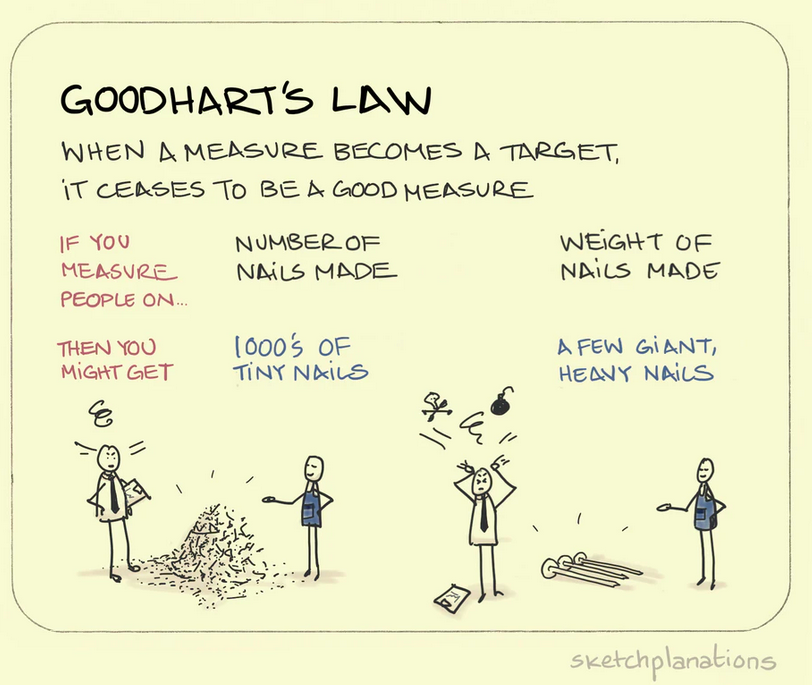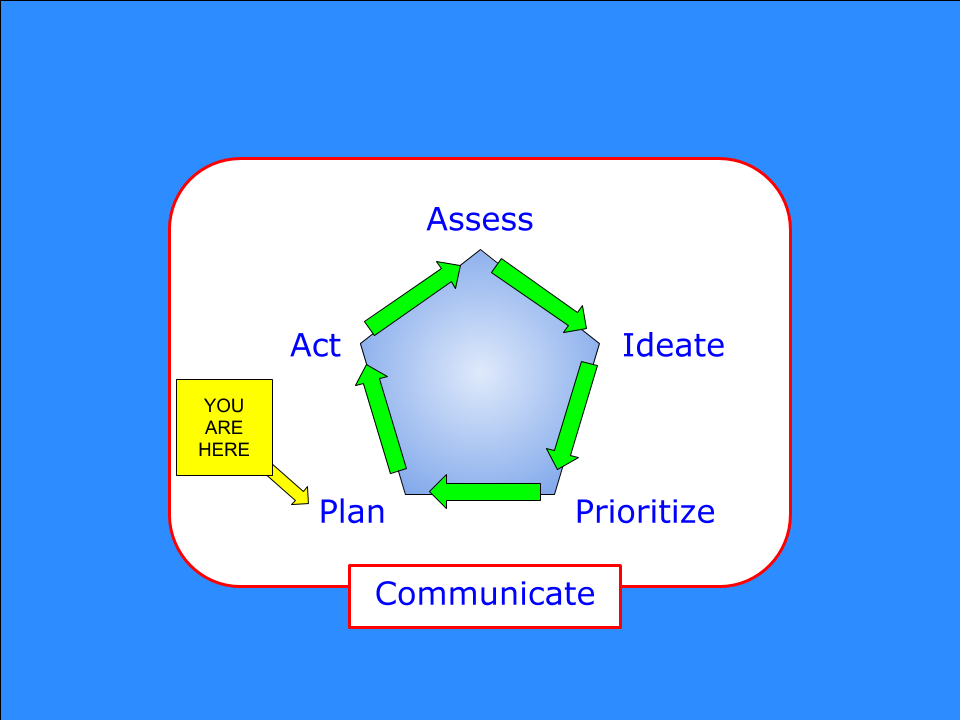Introduction
Today we’re continuing our exploration of the fourth phase in the planning framework – Plan. In the first article on the Plan phase, we covered the steps to create a draft plan to address specific objectives. In this article, we’ll complete the process by refining your plan, defining the measures of progress and success, and developing the communications agenda.
If you have not already read the first article on Developing a Plan, I recommend you do so now.
This is the latest in a series of articles about planning in uncertain times. In the first article, I introduced the framework – a repeatable cycle made up of six phases. The other articles are:
- Phase 1 – Assess
- Phase 2 – Ideate
- Phase 3 – Prioritize
- Phase 4 – Plan
- Part 1 – Developing a Plan
- Part 2 – Refining Your Plan – this article
- Phase 5 – Act
- Phase 6 – Communicate
This article is the second of two that will focus on the fourth phase of the cycle – Plan.
The final article of this series will explore the Act phase.

Let’s begin with a quick recap of the Plan phase.
Objectives and Outputs of the Plan Phase
There are two objectives of the Plan phase:
- To develop a comprehensive, actionable plan that addresses the prioritized actions.
- To define measures of progress and success.
The outputs of the Plan phase are:
- A detailed plan that shows tasks, assignments, durations and resource estimates.
- A list of assumptions made during the creation of the plan.
- Updated notes on conflicts and interdependencies.
- Cost estimates for planned activities.
- A “risk register” that captures information about risks and mitigations.
- A set of measures to track progress and evaluate success.
We addressed the first three outputs in the last article. Now we’ll focus on the secondlast outputs.
The Plan Process, continued
There are five steps in the Plan phase:
- Assemble the team
- Develop the draft plan
- Refine the plan
- Develop the measures
- Communicate status and results
We’ve already discussed the first two steps. This article will cover the last three. Let’s jump right in.
Refine the Plan
Once you have developed a solid draft plan, the next step is refining your plan. This involves evaluating risks, estimating costs, doing a cost / benefit analysis, and making any necessary revisions.
Evaluate Risks
“It does not do to leave a live dragon out of your calculations, if you live near one.”
J.R.R. Tolkien, The Hobbit

While it’s unlikely that you’ll list “nearby dragons” as a risk, it’s important to think carefully about risks you can see, and more importantly to identify the ones that are not readily visible.
In my experience, teams do a better job of identifying risks when they respond to questions or prompts than when they start with a blank sheet of paper. You have several good inputs available from prior phases.
During the Assess Phase, you conducted a SWOT analysis to evaluate the current state of your organization. During that analysis, we used a lengthy list of questions to prompt discussion. Many of those questions could be used now to generate ideas about risks that may have not been evident in earlier phases.
In the Ideate Phase, you identified potential risks associated with each proposed action. These were captured in the Idea Map document, along with possible mitigation steps. Now is the time to review and update those notes.
As you update your list of risks and mitigations, add them to a formal Risk Register – a document that captures the details of each risk, including:
- The likelihood that it will occur
- The potential impacts (including costs)
- Steps needed to mitigate or lessen the impact of the risk
- Contingency actions to take if the risk does occur
- The individuals or teams responsible for “owning” the risk
If mitigation steps are known, but not yet implemented, add tasks to your plan that reflect the work that remains to be done. You want to ensure that every risk identified is addressed, either by tasks in the plan or entries in the risk register.
I have created a simple risk register template that you can download.

Estimate Costs
Every task in your detailed plan should have an estimated cost. Your finance or accounting organization should be able to provide some guidance on the accepted methods for estimating within your company. Here are some general rules that have worked well for me:
- People costs: Calculate standard cost per hour values to use for estimating the cost of people’s time. You may need different values for employees versus contractors or other third parties.
- Tools, equipment, software and other purchased products or services: Create an estimate cost based on past experience or quotes from suppliers.
- Unexpected costs: You’re creating an estimate, but you also know that there will be unexpected costs. Give yourself a margin of error by adding a percentage of your total. 20 – 25% is a reasonable place to start, but in some situations you may need to add more buffer. This estimate can be reduced as you learn more and continue refining your plan.
Conduct a Cost / Benefit Analysis
Once you have completed the cost estimate, you can compare the costs to the value of the benefits you anticipate from successfully executing the plan. You want to answer the fundamental question “Is this plan worth doing?”, which is the exact question your executive sponsors and high-power stakeholders will be asking.
If your benefits clearly outweigh the costs, you’re in good shape. But many times it will be difficult to determine the value of the benefits. And if the costs exceed the benefits, you will want to revisit your estimates to make adjustments that narrow the gap. This could mean trimming cost estimates as well as expanding benefit estimates. Just make certain that any changes you make are reasonable and justifiable.
In some situations, like developing a plan to address legal or regulatory compliance issues, the costs involved with a plan may not be a major consideration. In these cases, you have no choice about whether or not to implement your plan, but you almost always have choices about how much it will cost. Don’t assume that a mandatory action comes with a blank check!
Revise the Plan as Needed
I’ll repeat the same caution from the last article – don’t get caught in analysis paralysis! That said, you may need to make further revisions in order to have a “doable” plan. If you determine that your project is too big, too complex, too expensive or just not feasible, then you’ll need to make changes. Some options to consider include:
- Breaking one large project into several smaller projects.
- Reducing the scope of the project.
- Planning a pilot project to prove the concepts and demonstrate the benefits.
Even if you don’t need to make major changes, you may still need to adjust some aspects of your plan. Just remember that you will be continuously refining your plan throughout the implementation in the Act phase. Plans are never perfect, and they are only 100% complete when the project is finished. Shoot for “good enough” and move on.
Develop the Measures
The next step in the Plan phase is to define the measures or metrics that will enable you to track progress as you execute your plan, identify when you’re going off course and measure the success of your efforts. It’s helpful to think about two types of measures: execution measures and success measures.
Execution measures track the progress of the project. These measures help you evaluate your performance as you execute your plan. They can include:
- Number and % of plan tasks completed
- % of tasks completed on schedule
- Budget variance: actual project costs vs. estimates
- Earned Value Analysis (EVA) – a ratio of the percent of project tasks completed vs. the percent of budget spent.
Success measures indicate how well you achieved your objectives. Success measures relate directly to the business objectives you defined as you developed your draft plan. For example, if your objective is to increase revenue by 5% in the next 12 months, a success measure could be the percentage of revenue increase each month. Defining the measure may be as simple as asking “How will we know we are successful?”
Some rules of thumb to consider as your develop your metrics:
- Keep them simple and understandable. Your measures should be relevant to your team and your stakeholders.
- Select measures for which data is readily available. You want to devote your energy to implementing the plan, not trying to wrangle data to report something esoteric. If the data you need for a measure is not a logical output of your planned work, consider a different measure.
- Remember Goodhart’s law – “When a measure becomes a target, it ceases to be a good measure.” In practice, this means that human beings will inevitably try to game the system in order to hit the target. A great illustration comes from Jono Hey at sketchplanations.com:

- One way to avoid the impact of Goodhart’s law is to create balanced sets of measures to avoid unintended consequences. A classic example comes from call centers or help desks. Many of them measure the length of time that agents are on the phone, emphasizing shorter calls. By itself, this measure can lead to agents rushing through calls and hanging up before the customer’s issue is resolved. A balancing metric of customer satisfaction can help ensure that the right behavior is rewarded.
Communicate Status and Results
The last step in the process is to communicate status and results, using the guidance published in the Communicate phase article. As a reminder, the six steps in Communicate are:
- Update your stakeholder analysis
- Ask the six questions – Why? Who? What? How? Where? When?
- Update the communication plan
- Create message triangles
- Create the communication material.
- Deliver the messages
Three specific communication actions from this phase are:
- Socialize your plan with sponsors and high-power stakeholders to ensure support. You are now ready to move ahead into the Act phase, where you’ll actually launch your project and get started with the work. You want to be certain that your key stakeholders and sponsors are on board and supportive.
- Socialize the plan with your delivery partners to ensure their alignment and commitment. During the Plan phase you have brought new groups into the process – teams that will be responsible for delivering or supporting different parts of your plan. Now is the time to review the completed plan with them and iron out any issues with timing or deliverables.
- Communicate with groups that will be impacted by the planned activities. As noted in the Communicate phase article, your audience of stakeholders will grow during each successive cycle. It is now almost as big as its going to get. By refining your plan, you will now have a clear idea of all the individuals, groups and organizations that your project will impact. These folks deserve some notice, if they haven’t already been informed or consulted. Depending on the scope of your project, you may need to consider a formal organizational change management approach to help prepare these groups for the changes to come.
Conclusion
Your plans will never be complete. They will change constantly as you begin to implement them. But by investing time and attention to developing and refining your plan, you set yourself and your team up for success.
In the last article of this series, we will look into the final phase – Act – where all of our work comes to fruition in a successful implementation of the prioritized actions.
To your success,

Help me set the agenda for future articles.
There’s one more article in the Planning Framework series. After that, we’ll move on to other topics.
I’d appreciate your suggestions on what subjects you’d like to hear about in the coming weeks.
Add your thoughts in the comments below or send me a note through the Contact Form.

